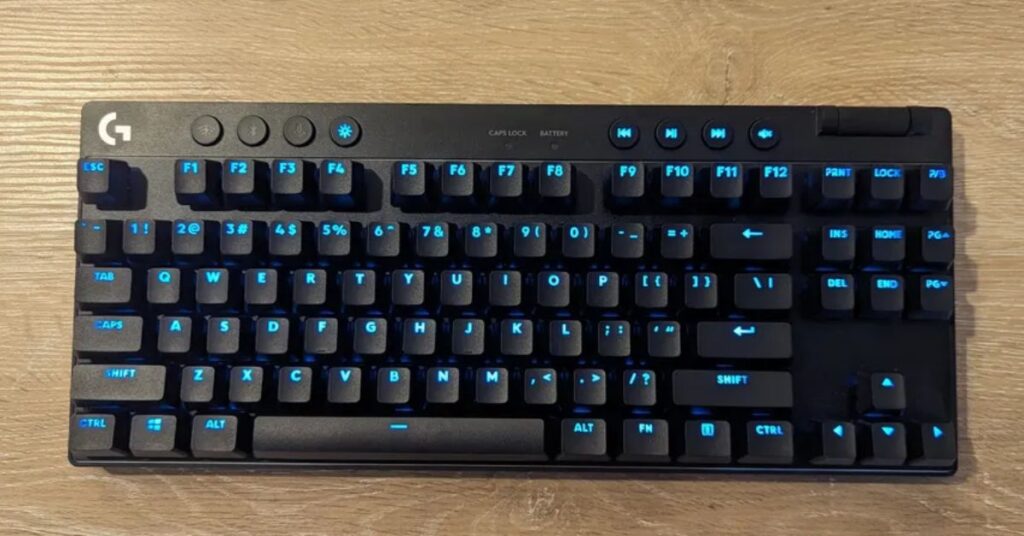A keyboard typing incorrect characters can be frustrating, especially when you rely on it for work, school, or personal use. This issue occurs when you press a key, but a different letter, number, or symbol appears on the screen. For example, pressing the “@” key might show a different character like “£,” or typing “A” might display “Q.” In some cases, multiple keystrokes result in unintended outputs, making typing nearly impossible.
This issue can happen suddenly or after making certain changes to your system, such as updating software, adjusting settings, or connecting a new keyboard. The problem might be related to software settings, driver issues, or even physical damage to the keyboard. Identifying the root cause is essential to finding the right solution.
Common Situations Where This Happens
People often experience this problem in different scenarios. One common situation is when a user unknowingly changes their keyboard layout settings, especially when switching between multiple languages. This can cause specific keys to produce different characters than expected. Another common case is after installing a new operating system update, where system settings might reset or change, leading to misconfigured input settings.
Sometimes, the issue appears when using an external keyboard, particularly if it has a different layout than the built-in laptop keyboard. Additionally, a malfunctioning keyboard due to dust, liquid spills, or general wear and tear can also contribute to incorrect character inputs. In more serious cases, software conflicts or malware infections can interfere with how the keyboard communicates with the system, leading to typing errors.
Possible Causes and Their Solutions
1. Incorrect Keyboard Layout Settings
One of the most frequent reasons a keyboard types incorrect characters is an accidental change in the keyboard layout. Different keyboard layouts exist, such as QWERTY, AZERTY, and Dvorak, and switching between them can cause confusion. For example, if the system is set to a French AZERTY layout instead of the standard QWERTY, pressing “Q” will produce “A” and vice versa.
To fix this on Windows, go to Settings > Time & Language > Language & Region > Keyboard layout and ensure the correct layout is selected. If you notice an unfamiliar layout, switch back to the standard US or UK layout, depending on your preference. On macOS, open System Settings > Keyboard > Input Sources and check that the correct layout is being used. If you see additional layouts that you don’t need, remove them to prevent accidental switching.
2. Language and Input Settings Mismatch
Language settings can also affect how a keyboard functions. If your system is set to a different language or input method than your actual keyboard, some keys may behave unexpectedly. For example, if your computer is set to a German keyboard layout but you are using a standard English keyboard, symbols and special characters will not align correctly.
To resolve this on Windows, open Settings > Time & Language > Language & Region and verify that the input method matches your keyboard type. On macOS, check System Settings > Language & Region and make necessary adjustments. If you frequently switch between languages, you can enable a language indicator on your taskbar to easily toggle between them when needed.
3. Sticky or Malfunctioning Keys
Over time, keyboards can accumulate dust, dirt, and debris, causing certain keys to stick or become unresponsive. Additionally, liquid spills can damage the internal circuits, leading to keys registering incorrect inputs. If specific keys consistently produce incorrect characters or don’t respond at all, the problem may be mechanical.
A good first step is to clean your keyboard using compressed air or a soft brush to remove any trapped debris. If a key is sticking, try gently lifting it (if your keyboard allows it) and cleaning underneath. For external keyboards, unplugging and reconnecting them can sometimes resolve temporary malfunctions. If cleaning does not solve the problem, consider using an external keyboard to test whether the issue is with the physical keys or a system setting.
4. Driver Issues or Outdated Keyboard Drivers
Keyboard drivers allow the operating system to communicate with the keyboard. If these drivers become outdated or corrupted, the keyboard may start behaving unpredictably. This is especially common after a system update or when using an external keyboard that requires special drivers.
On Windows, open Device Manager and navigate to Keyboards. Right-click your keyboard and select Update Driver to check for available updates. If updating does not work, uninstall the driver and restart your computer, allowing Windows to reinstall a fresh version automatically. On macOS, keeping your system up to date through System Settings > Software Update ensures you have the latest drivers.
If you suspect the issue is caused by a recent update, rolling back to a previous version of the driver or performing a system restore might help. If the problem persists, try connecting another keyboard to see if the issue is hardware-related.
5. Hardware Problems (Faulty Keyboard or Connection Issues)
Physical damage or connection issues can also cause a keyboard to type incorrect characters. If you are using a wired keyboard, a faulty USB port or damaged cable may interfere with proper functioning. For wireless keyboards, weak batteries or Bluetooth connectivity problems can lead to lag and incorrect inputs.
To troubleshoot, try connecting the keyboard to a different USB port or using another keyboard to see if the problem persists. If you are using a wireless keyboard, replace the batteries or re-pair the device with your computer. If none of these solutions work, the keyboard itself may be faulty and need replacement.
6. Malware or Software Conflicts
In some cases, malware or software conflicts can affect keyboard behavior. Certain malicious programs can interfere with system settings, causing keys to produce unexpected outputs. Keylogging malware, for instance, can modify keyboard inputs as part of its operation.
Running a full system scan with a reputable antivirus program can help detect and remove potential threats. If you installed new software before the issue started, consider uninstalling it to see if the problem resolves. Booting the computer in Safe Mode can also help determine whether the issue is caused by third-party software, as Safe Mode loads only essential system processes.
How to Fix Keyboard Typing Wrong Characters
If your keyboard is typing the wrong characters, don’t worry. This issue can usually be fixed with simple troubleshooting. Below are the most effective ways to solve the problem and prevent it from happening again.
Check and Change Keyboard Layout
One of the most common reasons for incorrect typing is that the keyboard layout has changed. Different keyboard layouts exist, such as QWERTY (used in the US) and AZERTY (used in France). If your system is set to the wrong layout, the keys will not match the expected output.
How to Fix on Windows:
- Open Settings and go to Time & Language.
- Click on Language & Region and check the Keyboard Layout.
- If an unfamiliar layout is selected, switch back to US English or your preferred layout.
- If multiple layouts are listed, remove the ones you don’t use to prevent accidental switching.
How to Fix on macOS:
- Open System Settings and go to Keyboard.
- Click Input Sources and verify that the correct keyboard layout is selected.
- Remove any unnecessary layouts to avoid confusion.
If you frequently switch between languages, you can enable a language indicator on your taskbar to see the active keyboard layout at all times.
Verify Language and Input Settings
Sometimes, the issue is caused by a mismatch between the selected language and the keyboard layout. For example, if your computer is set to a different language, certain symbols and letters may not appear as expected.
To check this, go to your system’s language settings and ensure that the correct language and input method are selected. If multiple languages are enabled, set your primary language as the default.
Restart the Computer
A simple restart can fix many temporary glitches, including keyboard problems. Restarting refreshes system processes and clears minor errors that might be causing incorrect keyboard behavior. Before trying more advanced troubleshooting steps, restart your computer and check if the problem persists.
Update or Reinstall Keyboard Drivers
Keyboard drivers allow your system to recognize and communicate with the keyboard. If the drivers are outdated or corrupted, they can cause typing issues.
How to Update Drivers on Windows:
- Open Device Manager by pressing Win + X and selecting Device Manager.
- Expand Keyboards and right-click your keyboard.
- Select Update Driver and choose Search automatically for drivers.
- If no updates are found, uninstall the driver and restart your computer. Windows will reinstall the correct driver automatically.
On macOS:
macOS automatically updates drivers when you update the system. Go to System Settings > Software Update and install any available updates.
Test with an External Keyboard
If your keyboard is typing the wrong characters, testing with an external keyboard can help determine if the issue is hardware-related.
- Connect an external USB or Bluetooth keyboard.
- Try typing to see if the issue persists.
- If the external keyboard works fine, your built-in keyboard may have a hardware problem.
If your built-in keyboard is faulty, you may need to replace it or use an external keyboard as a long-term solution.
Check for Malware and Perform a System Scan
Some malware can interfere with keyboard functionality, causing incorrect inputs or random characters to appear while typing. Running a full system scan with a trusted antivirus program can help detect and remove potential threats.
Steps to scan for malware:
- Open your antivirus software (such as Windows Defender, Avast, or Malwarebytes).
- Run a Full Scan to check for infections.
- If malware is detected, follow the recommended steps to remove it.
Keeping your system updated and avoiding untrusted websites can help prevent malware infections in the future.
Use On-Screen Keyboard for Troubleshooting
If your physical keyboard is not working properly, using an on-screen keyboard can help you troubleshoot.
On Windows:
- Press Win + R, type osk, and press Enter to open the on-screen keyboard.
- Click the keys to check if they work correctly.
On macOS:
- Go to System Settings > Accessibility > Keyboard and enable the on-screen keyboard.
This tool can be useful for diagnosing whether the problem is with the keyboard hardware or software settings.
Preventive Measures to Avoid Future Issues
To prevent keyboard issues in the future, follow these best practices:
- Regularly update drivers and software to avoid compatibility issues.
- Keep your keyboard clean by removing dust and debris that can cause stuck keys.
- Use reliable antivirus software to prevent malware from interfering with keyboard functions.
- Avoid installing unknown third-party keyboard software that may change your input settings.
Conclusion
A keyboard typing the wrong characters can be caused by incorrect settings, outdated drivers, malware, or hardware issues. The first step in fixing the problem is to check your keyboard layout and language settings. If that doesn’t work, try updating your drivers, restarting the computer, or testing with an external keyboard. Regular maintenance and security measures can help prevent similar issues in the future. Always check software settings before assuming a hardware failure, as most typing errors are caused by simple misconfigurations.


